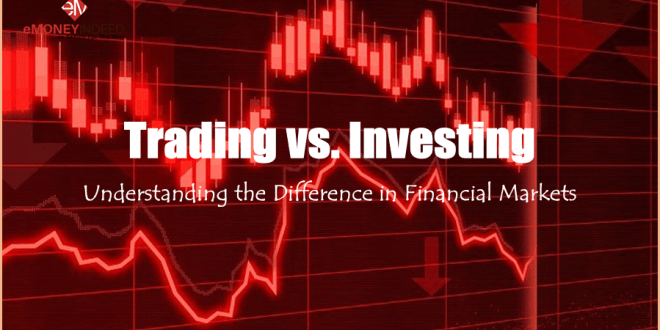Welcome to the appealing universe of financial markets, where every decision
carries the promise of financial growth and the thrill of uncertainty. Have you
ever wondered about the difference between trading and investing? In this
journey through the dynamic landscape of finance, we’ll undo the details of
trading and investing, shedding light on their distinct domains.
As you embark on this study, imagine the financial markets as a bustling
cityscape, with trading and investing as two distinct neighborhoods. The
traders, quick and decisive, navigate the narrow streets of short-term gains,
while the investors, patient and strategic, build their wealth on the sturdy
foundations of long-term growth.
So, tighten your seatbelt and get ready for an adventure through the highs
and lows of trading and investing. Let’s explore the bustling streets and quiet
alleys, decoding the language of charts and the wisdom of financial statements.
#I. What is Trading?
Trading, a dynamic dance within the financial markets, involves swift
decisions and short-term maneuvers to capitalize on market fluctuations. Unlike
the deliberate pace of investing, trading is a high-energy sprint, aiming for
immediate gains.
Read| The Benefits and Risks of Investing in Penny Stocks
Definition and Basic Concept: At its core, trading is the
art of buying and selling financial instruments, such as stocks or currencies,
with the goal of profiting from short-term price movements. Traders thrive in
the fast-paced environment, leveraging technical analysis and quick decision-making
to navigate the volatility of financial markets.
Short-Term Goals and Time Horizon: Traders operate with a
keen eye on short-term goals, seeking to capitalize on market opportunities
within days, hours, or even minutes. Their time horizon is compressed,
requiring a nimble approach to react swiftly to market changes.
Key Characteristics of Traders:
Quick Decision-Making: Traders are similar to sprinters,
making fast decisions based on real-time market data. The ability to analyze
information quickly and act decisively is a hallmark of successful traders.
Technical Analysis: Charts and patterns become the language
of traders. Technical analysis, involving the study of historical price
movements, guides their predictions and entry/exit points.
Risk Management: Trading is not without risks, and
effective risk management is crucial. Traders employ stop-loss orders and other
strategies to protect their capital while navigating the unpredictable market
terrain.
#II. What is Investing?
Investing is the thoughtful art of wealth-building through strategic
financial decisions. It’s a patient philosophy that surpasses the mad pace of
trading, emphasizing the power of time and compounding to yield lasting
returns.
Definition and Core Principles: At its core, investing
involves allocating funds to assets with the expectation of long-term growth.
This disciplined approach contrasts sharply with the rapid-fire nature of
trading, encouraging a more measured and calculated strategy.
Long-Term Goals and Time Horizon: Investors are like
architects of their financial future, set their sights on prolonged objectives
such as retirement or educational funding. Their time horizon is long, allowing
them to steer market fluctuations and harness the inherent upward momentum of
carefully selected assets.
Key Characteristics of Investors:
Fundamental Analysis: Investors engage in deep fundamental
analysis, analyzing financial statements and market trends. This investigative
approach guides their decision-making, focusing on the fundamental value of
assets.
Patience and Discipline: Patience is the investor’s virtue.
They resist the urge for impulsive reactions, understanding that
wealth-building is a gradual process. Discipline ensures adherence to chosen
strategies despite short-term market movements.
Diversification: Investors safeguard against risk through
portfolio diversification. By spreading investments across various asset
classes, they create a strong financial foundation capable of withstanding
market volatility.
#III. The Key Differences Between Trading and Investing
When comparing how people handle money, trading and investing are like
sprinting and marathon running. They are quite different approaches in the
world of finance.
Also See| Top 10 Tips for Trading Forex Successfully
Time Horizon: Sprinting vs. Marathon: The main difference
lies in time perspective. Trading operates on a sprinter’s clock, focusing on
short-term gains within days or minutes. In contrast, investing adopts the
marathon mindset, patiently waiting for the compounding effects to unfold over
an extended period.
Risk Tolerance: Roller Coaster vs. Steady Climb: Risk
tolerance is another differentiating factor. Traders, like thrill-seekers on a
roller coaster, embrace volatility for potential quick gains. On the flip side,
investors prefer a steadier climb, navigating market ripples with a more
resilient and composed outlook.
Approach to Analysis: Charts vs. Fundamentals: The
analytical approach is a telling contrast. Traders immerse themselves in charts
and technical analysis, decoding complex patterns for market entry and exit.
Investors, however, look into fundamentals—analyzing financial statements,
economic indicators, and a company’s intrinsic value.
Emotional Resilience: Navigating Highs and Lows: Emotional
resilience sets the two apart. Traders must weather the emotional roller
coaster of rapid market shifts, requiring a quick recovery from both gains and
losses. Investors, in their steady climb, cultivate a more composed approach,
less swayed by short-term market noise.
As we look into these differences, it becomes clear that choosing between
trading and investing is not merely a financial decision but a lifestyle
preference.
#IV. Pros and Cons of Trading vs. Investing
In the dynamic world of finance, both trading and investing present unique
advantages and challenges, offering a diverse array of opportunities for wealth
creation.
Trading Advantages:
Quick Profits: Traders revel in the potential for rapid
gains, seizing opportunities presented by short-term market fluctuations.
Flexibility: The nimble nature of trading allows for quick
adjustments to market trends and immediate responses to breaking news.
Excitement and Challenge: For those who thrive on
excitement and the challenge of reading market charts, trading provides a
thrilling and engaging experience.
Trading Challenges:
High Risk: The rapid pace of trading comes with heightened
risk, requiring constant vigilance and effective risk management strategies.
Time-Intensive: Trading demands significant time and
attention, making it less suitable for individuals with busy schedules or those
seeking a more passive approach.
Investing Advantages:
Long-Term Growth: Investing focuses on the power of
compounding, offering the potential for substantial long-term growth and wealth
accumulation.
Less Time-Consuming: Investors enjoy a more relaxed pace,
requiring less frequent monitoring compared to the constant attention demanded
by trading.
Diversification: With a longer time horizon, investors can
build diversified portfolios, spreading risk across various asset classes for
more stable returns.
Investing Challenges:
Patience Required: Success in investing demands patience,
as significant returns may take years to materialize.
Market Fluctuations: Investors must navigate market
fluctuations without succumbing to emotional reactions, which can be
challenging during periods of volatility.
Whether you lean toward the thrill of trading or the steadiness of
investing, understanding the pros and cons is crucial for making informed
financial decisions.
#V. Which One is Right for You?
Choosing between trading and investing is similar to selecting a path in the
financial landscape, each offering distinct rewards and challenges. To
determine which suits you best, consider the following factors:
Must Read | 5 Common Mistakes Beginners Make in the Stock Market
Assessing Your Financial Goals: Define your objectives. Are
you aiming for quick returns or long-term wealth accumulation? Trading aligns
with short-term goals, while investing caters to those with a patient eye on
the future.
Understanding Your Risk Tolerance: Evaluate your comfort
with risk. If you thrive on adrenaline and can navigate market volatility
without losing sleep, trading might be your forte. Investors, on the other
hand, embrace a more composed and steady approach.
Finding Your Comfort Zone: Consider your lifestyle and time
availability. Trading demands active involvement, often requiring daily
attention. If you seek a more relaxed approach and have limited time for daily
market scrutiny, investing may be a better fit.
Remember, there’s no one-size-fits-all answer. Your financial journey is
uniquely yours, shaped by personal preferences and aspirations. Some
individuals find a harmonious balance by incorporating elements of both trading
and investing into their strategy.
#VI. Real-Life Examples
Embarking on a financial journey can be enriched by exploring the real-life
tales of those who navigated the diverse landscapes of trading and investing,
carving their paths to success.
Stories of Successful Traders:
George Soros – The Currency Speculator: Renowned for
breaking the Bank of England in 1992, Soros demonstrated the prowess of a
skilled trader. His ability to predict and capitalize on market trends
contributed to substantial profits.
Paul Tudor Jones – The Contrarian Investor: While primarily
a trader, Jones occasionally embraced an investor’s mindset. His notable
success in predicting the 1987 market crash showcased the value of adapting
strategies to market conditions.
Tales of Wealthy Investors:
Warren Buffett – The Sage of Omaha: Buffett’s patient and
value-driven investing approach transformed him into one of the world’s
wealthiest individuals. His commitment to long-term investments in
fundamentally sound companies exemplifies the power of compounding.
Peter Lynch – The Stock-Picking Guru: Lynch’s success as a
mutual fund manager stemmed from his knack for identifying promising stocks.
His “buy what you know” philosophy resonates with investors seeking
simplicity and a deep understanding of their investments.
These real-life examples highlight the diverse paths one can take in the
financial realm. Whether you resonate with the agility of Soros or the enduring
wisdom of Buffett, these stories illuminate the possibilities within the
dynamic worlds of trading and investing.
#VII. Tips for Success
Embarking on a journey through the financial markets requires not just
knowledge but a strategic approach. Whether you’re inclined towards trading or
investing, here are some key tips for success:
Trading Strategies:
Educate Yourself: Prioritize continuous learning. Stay
updated on market trends, technical analysis, and evolving strategies. A
well-informed trader is a successful trader.
Risk Management: Mitigate risk by setting clear stop-loss
levels and diversifying your portfolio. Prudent risk management is crucial to
weather the inherent volatility of trading.
Discipline is Key: Establish a trading plan and stick to
it. Emotional discipline prevents impulsive decisions, fostering a steady and
strategic approach.
Investment Principles:
Patience Pays Off: Adopt a long-term mindset. Successful
investors understand that wealth-building is a gradual process, and the power
of compounding requires time to unfold.
Diversify Your Portfolio: Spread your investments across
different asset classes. Diversification minimizes risk and ensures your
portfolio remains resilient to market fluctuations.
Research Thoroughly: Conduct in-depth fundamental analysis
before making investment decisions. Understand the financial health of the
companies or assets you’re considering.
Balancing Both Worlds:
Hybrid Strategies: Explore hybrid approaches that
incorporate elements of both trading and investing. This allows for agility in
capturing short-term opportunities while maintaining a foundation of long-term
stability.
Continuous Evaluation: Regularly reassess your financial
goals, risk tolerance, and market conditions. Adapt your strategies accordingly
to align with your evolving circumstances.
Remember, success in the financial markets is a dynamic process that
requires adaptability and a commitment to continuous improvement. Whether you
find resonance in the agile tactics of trading or the patient strategies of
investing, these tips serve as guiding principles on your path to financial
prosperity.
#VIII. Conclusion
The choice between trading and investing is not just a financial decision;
it’s a reflection of your goals, temperament, and approach to wealth creation.
As you navigate this captivating landscape, remember that your financial
journey is uniquely yours. Embrace the lessons from both traders and investors,
finding a balance that aligns with your aspirations. Whether you sprint,
stroll, or find a rhythm in between, the world of finance welcomes those ready
to explore, learn, and grow.
May your financial journey be fulfilling, rewarding, and uniquely yours.
Here’s to the exciting roads ahead and the wealth of possibilities waiting to
be discovered! Safe travels on your financial adventure!



